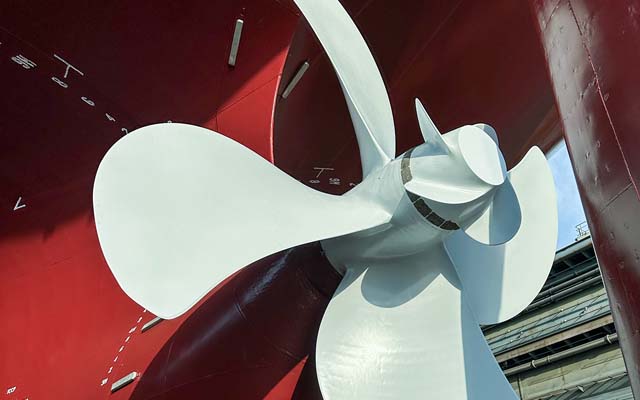Grieg Maritime’s vessel ‘Star Lysefjord’ recently emerged from drydock after installing three measures to increase the vessel’s energy efficiency and make it more climate-friendly.
The first of these measures is coating the hull and propeller with a graphene-based coating. Biological fouling—the accumulation of microorganisms, plants, algae, and small animals like barnacles on the hull—increases resistance and slows down vessels by between 3% and 7% during the five years between each drydocking. This leads to increased energy consumption and, thus, CO2 emissions to keep up to speed. Hull coatings usually rely on biocides, which are gradually released to keep the surface clean. There is growing concern about the effect of biocide releases on the ocean, and many types are already banned.
Unlike traditional hull coatings, the chosen graphene coating is free of biocides and silicone oils. It does not release anything into the ocean, making it a more environmentally friendly choice. Moreover, it creates an ultra-low friction surface, preventing the attachment of biofouling and reducing energy consumption from day one. The supplier, GIT Coatings, tested the product at the University of Strathclyde, and it was proven to have up to 15% less drag than soft foul-release coatings.
Microscopically, graphene is believed to be the strongest material ever measured, with exceptionally high tensile strength, electrical conductivity, and transparency and is the thinnest two-dimensional material. Traditional coatings need to be sandblasted and reapplied every five years. Due to the strength of this new solution, Grieg expects it to last 10 years.
Star Lysefjord is Grieg’s first vessel equipped with this innovative graphene-based coating. This advancement promises more efficient sailing, less fouling, and a significant reduction in energy consumption.
In addition to the new coating, two other measures are being trialled: propeller boss Ccap fins and ultrasonic hull protection. The first is a well-known tech that reduces and almost eliminates the vortex that often is developed at the tip of the propeller’s boss cap. That means more efficiency and less energy consumption. Grieg has the boss cap fins on the entire K-class and now on two L-class vessels. The boss cap fins of Star Lysefjord even have a thin layer of graphene-based coating.
The other tech is ultrasonic hull protection against fouling. It has been tried and tested on niche areas such as coolers and seachests, and Grieg has experience with installations on propellers. This time, a test patch with ultrasonic protection was installed on the hull plating. Placing the transducer units inside the harsh environment of ballast tanks is a new challenge, and the actual working radius of the units is also uncharted territory for hull protection.
Image: ‘Star Lysefjord’ propeller boss fins (source: Grieg Maritime)



